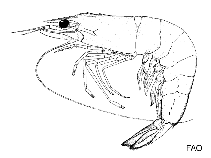Penaeus indicus Milne-Edwards, 1837
Indian white prawn
Классификация / Names народные названия | синонимы | CoL | ITIS | WoRMS
Malacostraca | Decapoda | Penaeidae
Environment: milieu / climate zone / пределы глубины / distribution range экология
; солоноватоводный; пределы глубины 0 - 90 m (ссылка 8), usually 0 - 10 m (ссылка 110177). Tropical, preferred 27°C (ссылка 107945); 30°N - 31°S, 30°E - 168°E
Distribution страны | регионы FAO | Ecosystems | места находок | интродукции
Indo-Pacific: From northeast Africa to south China, Malaysia, Indonesia and north Australia. Introduced in southeast Africa.
Length at first maturity / Size / Weight / Возраст
половая зрелость: Lm 12.2, range 4 - 3.9 cm Max length : 20.5 cm TL самец/пол неопределен; (ссылка 119750); 23.5 cm TL (female); common length : 17.0 cm TL самец/пол неопределен; (ссылка 8); наибольший вес (опубликованные данные): 35.00 g (ссылка 116487)
Краткое описание морфология
Life cycle and mating behavior половая зрелость | размножение | нерест | Eggs | Fecundity | Larvae
Основная ссылка
ссылки | координатор | соавторы
Holthuis, L.B. 1980 FAO Species Catalogue. Vol. 1. Shrimps and prawns of the world. An annotated catalogue of species of interest to fisheries. FAO Fish. Synop. 125(1):271 p. Rome: FAO. (ссылка 8)
Статус Красного Списка МСОП
(ссылка 130435: Version 2025-1)
Статус СИТЕС (ссылка 108899)
CMS (ссылка 116361)
Угроза для людей
Использование человеком
рыболовство: коммерческий
FAO - аквакультура (рыбоводство): production, Видовой профиль; рыболовство: landings, Видовой профиль | FishSource | Sea Around Us
инструменты
дополнительная информация
ресурсы в Интернет
BHL | BOLD Systems | CISTI | DiscoverLife | FAO(аквакультура (рыбоводство): Видовой профиль; рыболовство: Видовой профиль; publication : search) | Fishipedia | GenBank (Геном, Нуклеотид) | GloBI | Gomexsi | Google Books | Google Scholar | Google | PubMed | Tree of Life | Wikipedia (Вперёд, поиск) | Zoological Record



